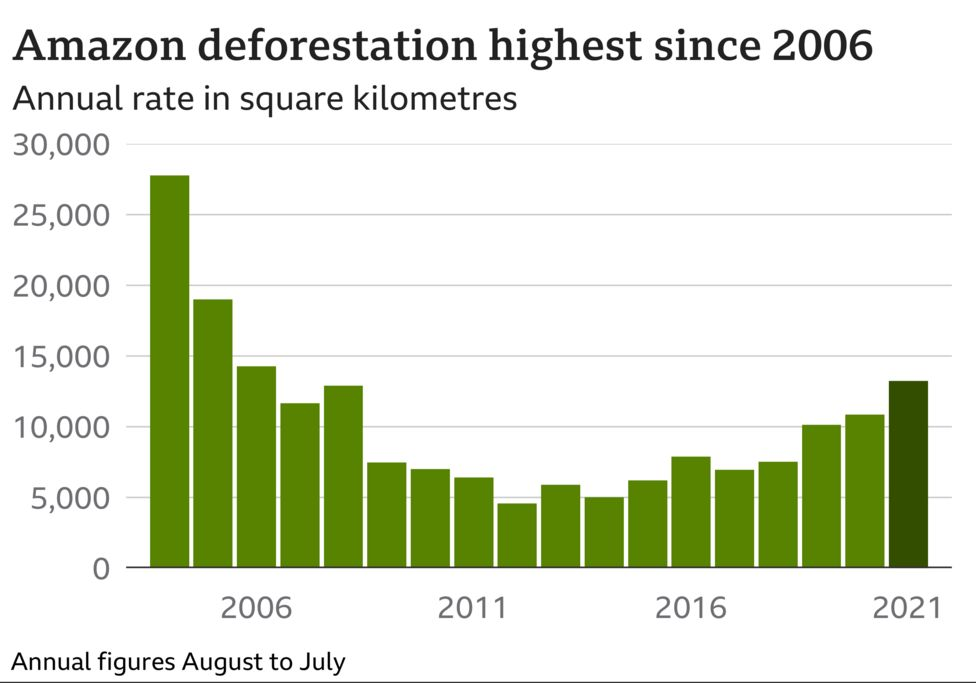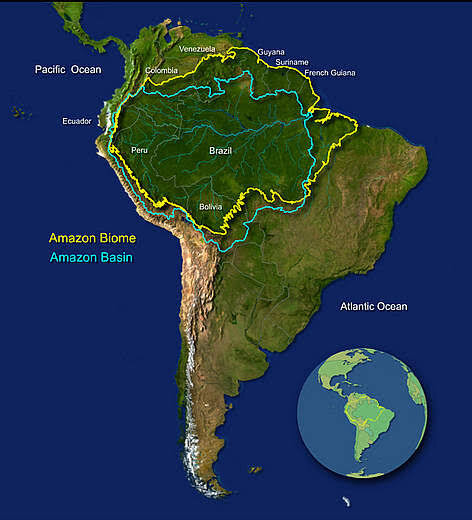Amazon Deforestation | 22 Nov 2021
Why in News
Recently, it was found that the area deforested in Brazil's Amazon reached a 15-year high after a 22% jump from the prior year (2020).
- Earlier, a study showed that Amazon Forests have started emitting Carbon dioxide (CO2) instead of absorbing it.
- Over time, global climate change and more deforestation will likely lead to increased temperatures and changing rain patterns in the Amazon, which will undoubtedly affect the region’s forests, water availability, biodiversity, agriculture, and human health.
Key Points
- Drivers of Deforestation in the Amazon:
- Cattle Ranching:
- One of the leading causes of deforestation in the Amazon Rainforest is linked to beef consumption.
- Vast areas of forest are cleared by cutting down trees and burning the forest down in order to create pasture land for grazing cattle.
- Brazil is a major supplier of beef to countries like the United States and China, exporting 1.82 million tons in 2019 alone.
- Small-Scale Agriculture:
- It has long been touted as a major driver of deforestation in the Amazon Rainforest.
- As with ranching, small-scale agriculture requires the forest to be “slashed and burned” to clear the ground for crops and grazing of various types.
- Fires:
- Unlike other types of forests, the Amazon did not evolve to burn.
- And in the Amazon basin, fires can actually be spurred by deforestation. As their name suggests, rainforests contain high levels of moisture, which helps buffer them from fire.
- Industrial Agriculture Operations:
- Industrial agriculture operations are becoming increasingly common in the Amazon Rainforest.
- Other Reasons:
- Mining operations, for sought-after minerals such as gold, account for further damage to the Amazon forest.
- Increased government incentives in the form of loans and infrastructure spending, including roads and dams.
- Cattle Ranching:
- Amazon Rainforests:
- These are the world's largest tropical rainforest occupying the drainage basin of the Amazon River and its tributaries in northern South America.
- Tropical forests are closed-canopy forests growing within 28 degrees north or south of the equator.
- They are very wet places, receiving more than 200 cm rainfall per year, either seasonally or throughout the year.
- Temperatures are uniformly high - between 20°C and 35°C.
- Such forests are found in Asia, Australia, Africa, South America, Central America, Mexico and on many of the Pacific Islands.
- The Amazon is a vast biome that spans eight rapidly developing countries—Brazil, Bolivia, Peru, Ecuador, Colombia, Venezuela, Guyana, and Suriname—and French Guiana, an overseas territory of France.
- The Amazon rainforests cover about 80% of the Amazon basin and they are home to nearly a fifth of the world’s land species and is also home to about 30 million people including hundreds of indigenous groups and several isolated tribes.
- The Amazon basin is huge with an area covering over 6 million square kilometres, it is nearly twice the size of India.
- The basin produces about 20% of the world’s flow of freshwater into the oceans.
- Comprising about 40% of Brazil’s total area, it is bounded by the Guiana Highlands to the north, the Andes Mountains to the west, the Brazilian central plateau to the south, and the Atlantic Ocean to the east.
- These are the world's largest tropical rainforest occupying the drainage basin of the Amazon River and its tributaries in northern South America.
- Initiatives to tackle Deforestation:
- Brazil was among a number of nations who promised to end and reverse deforestation by 2030 during the COP26 climate summit.
- LEAF (Lowering Emissions by Accelerating Forest Finance) Coalition was announced at the Leaders Summit on Climate, 2021.
- REDD+ initiatives: It is one of the climate change mitigation options in developing countries for conservation of forest carbon stock, sustainable management of forests and reducing emissions from deforestation and forest degradation.


